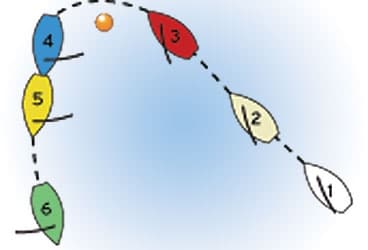
Ziskind technique 368
| **** |
| A sample break down of crew duties for a break-away set. |
I was once hired to help a Chicago-based team transition from their J/105 to a Farr 40. These guys were very good on the J/105 circuit, and all are great sailors. But the Farr 40 is a different animal. It requires a handful of additional sailors, more intricate boathandling maneuvers, and up to four of the crew can be professional sailors, so a higher standard of performance is required. The crew was enthusiastic to learn so we dedicated two weeks to evening boot camp. The goal was to have their maneuvers tight for an upcoming pair of fleet and match-racing regattas.
First we assigned everyone a position on the boat. Then we choreographed each assignment during each maneuver. The word choreography may bring to mind elaborate chorus line routines, but a big-boat maneuver is a lot like a group dance routine. Everyone has different jobs, and if the timing is off, the whole thing can turn out awful. On BMW Oracle Racing we choreographed every one of our key maneuvers. It’s a great way to get a new crew working on the same page. It’s also an excellent way to solve persistent crewing mistakes and get a veteran team operating at a higher level.
Creating this choreography is best done during a group session. The best part of this exercise is finding better ways to sail the boat. Initially we had everyone, from the bowman to the tactician, write a list of their duties for specific maneuvers, and for each maneuver we had an Excel spreadsheet to divide the duties among the team and detail when each task must be completed. Breaking down each maneuver into simple short statements, makes it easy for anyone to follow. (The diagram at right is an example of how we’d break down a bear-away set.) This allows us to make sure all the pieces of the puzzle fit together. It’s also easy to go over these parts and make simple adjustments in order to fine tune the maneuver. For example, it’s pretty tough for the pitman to ease the jib halyard while pulling the spinnaker halyard. So we got the cockpit floater involved and suddenly the jib was coming down as the spinnaker reached the masthead.
Once you go through the initial effort to plan out all your major maneuvers, it’s important to make sure the team routinely updates the spreadsheet as moves are modified. It can take a few regattas before every maneuver is smooth and even after that, there’s always room for improvement. In addition to refining your teamwork, the spreadsheet is also a tool for integrating a new crewmember. When he or she comes on board, they can be given a cheat sheet for each maneuver and have an immediate understanding of their responsibilities.
Once my J/105 team got its crew work down and modified each and every position, we then applied it to match racing. We took the same approach as we did the crew work. We created a choreographed step-by-step plan for each common match-racing move. For example, upon entering the starting box on port, we had choreographed a move such that, if we had enough windward separation during the dial-up, we would swing behind the starboard boat and sail past its transom. It might sound easy, but it requires precision crew work. First, you enter, then you slow down while dialing up, then the bowman backs the jib to port, the trimmer then takes over the back, the main gets eased all the way and the entire crew gets onto the windward side of the boat. All this must be coordinated for the move to work.
We put down specifics on detailed diagrams and each crew got a copy so when the situation developed, everyone was on the same page. We went through our fundamental diagrams as a group and discussed the boat handling and strategy associated with the maneuver and what we wanted to accomplish. If this works for a match racing move, think of what you can do by choreographing holding a spot on the line, shooting a weather mark, or simply ducking a starboard tacker.









